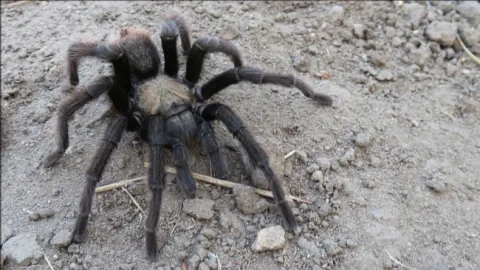
California Tarantulas (Aphonopelma sp.)
By Norman Smith
This is the time of year when you might see tarantulas wandering around the woodlands and crossing roads, often in broad daylight - unusual for a spider. Well, what you are seeing are male tarantulas, looking for a female. It is mating season, and since females do not leave the burrow (too dangerous for a female who probably has a large load of eggs to be laid to risk being eaten by a predator) the males must go find them. That usually means doing a considerable amount of wandering until they find a female burrow. Males will begin tapping at the entrance to the burrow to announce their presence. If a female is ready to mate, she will exit the burrow and begin a courtship dance with the male. They mate face to face, the male having to lift the female up off the surface and deposit his sperm on the underside of her body. This of course is a very risky move for the male, which places her fangs directly above him. In order to provide a semblance of safety while in this position, the male has two hook-like appendages under each front leg that he can place under each or her fangs should she suddenly become “unamorous”.
Males seem to wander most often prior to a storm coming into the state. There must be something about the lowering air pressure that initiates the sex drive in the male. I was back east in early October when we had a substantial rain storm here in San Luis Obispo County. Most likely there were several males wandering around prior to that storm. About a week after that rain, I received some inquiries regarding some web like deposits that were especially common in Los Osos. This appeared to be webbing that spiders spin to expand their range - called ballooning.
The young spiderlings will crawl up on the webbing that the adult female is spinning and then float away on the wind. These patches of webbing can land almost anywhere the wind deposits them. Some are great spots for a young spider to begin life, others are not - such as in water or off the California coast. I'm not sure if this webbing was related to the tarantula mating and the rain, or if it was some other species of spider that produced it in response to the life-giving moisture.
Tarantulas are venomous, but they are not deadly. They also don't generally bite aggressively. Males can often easily be handled as long as one avoids sudden movements or grabbing or pinching any part of the spider's body or legs. Females use webbing to line their burrow, cover the eggs with an egg case, and ballooning. Prey is caught by ambush. Ground crawling insects that crawl too closely to their burrow will be snatched into the burrow and envenomed. Males are longer legged with a smaller abdomen, allowing for rapid locomotion, to both find a female and escape one quickly if she is not in a receptive mood. Females have shorter legs and a heavier body and larger abdomen. Males that are captured to raise and feed in a terrarium tank will live for a while, but they are at the end of their life and will not survive much more than a few months. Females are longer lived, many up to 13–15 years and make better pets, but usually must be dug out of their burrow.

